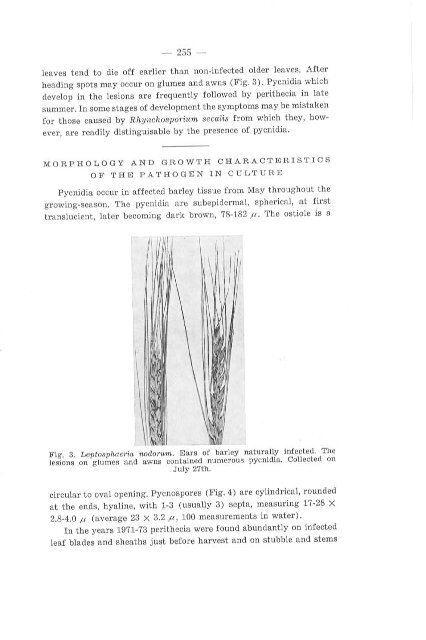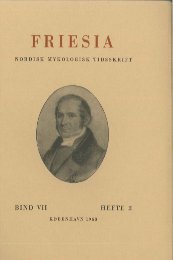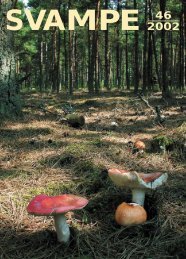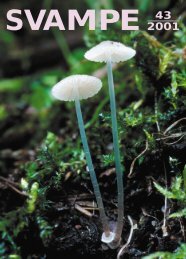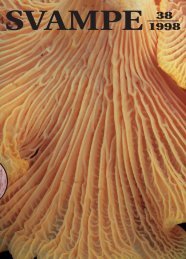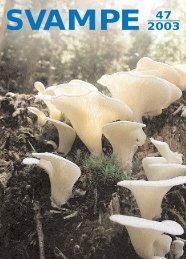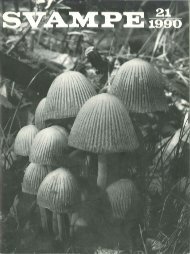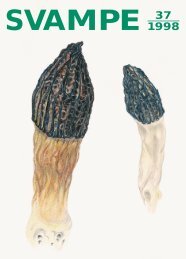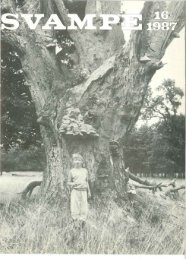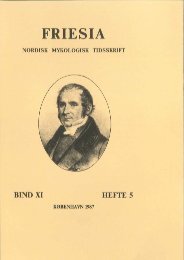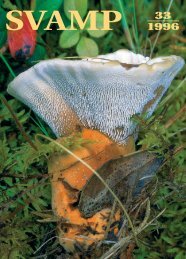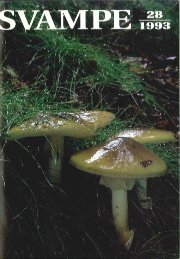- Page 1 and 2: FRIESIA NORDISK MYKOLOGISK TIDSSKRI
- Page 3 and 4: FRIESlA, Bind X, hefte 4-5, 1974 PL
- Page 5: - 210 - CONTENTS Page Introduetion
- Page 8: - 213 - deseribed in this paper do
- Page 11 and 12: - 216 - and nose, unitunieate, 120-
- Page 13 and 14: - 218 - This species is the marine
- Page 15 and 16: - 220 - and on shelIs and walls in
- Page 17 and 18: 222 - 12. Crinigera sp. (C. maritim
- Page 19 and 20: - 224 - 20-22.5 X 10-12 u , Ascospo
- Page 21 and 22: - 226- undoubtedly also H. appendic
- Page 23 and 24: - 228 - Paraphyses filiform. Ascosp
- Page 25: - 230 - Perithecia up to 0.5 mm in
- Page 28 and 29: - 233 - Rare. In old shipworm galle
- Page 30 and 31: - 235 - TABLE 1. Number of collecti
- Page 32 and 33: - 237 Fig. 11. Zone 1. Driftwood at
- Page 34 and 35: - 239- Within eaeh zone the driftwo
- Page 37 and 38: - 242- Dry driftwood also occurs at
- Page 39 and 40: - 244 - of marine fungi, but other
- Page 41 and 42: - 246- on the Helgoland coast found
- Page 43 and 44: - 248- pelaqica, Remispora hamata,
- Page 45 and 46: - 250 - Kohlmeyer. J.: Annotated ch
- Page 47 and 48: - 252 - lings in pots. In the latte
- Page 49: - 254 - Fig. 1. Leptosphaeria nodor
- Page 54 and 55: - 259- Perithecia of L. nodorum hav
- Page 56 and 57: - 261- plants remained healthy. The
- Page 58 and 59: - 263- brown, 78-182 u . Pycnospore
- Page 60 and 61: FRIESIA . Bind X . Hefte 4-5 . 1974
- Page 62 and 63: - 267 - Figs. 1 to 4. Chaetomium de
- Page 64 and 65: - 269 - ACKNOWLEDGEMENTS The author
- Page 66: 271 Fig. 1. Position of the localit
- Page 69 and 70: - 274 - usually suppcrted only a si
- Page 71 and 72: - 276- Fig. 3. The western edge of
- Page 73 and 74: - 278 - Fig. 4. The bur nt area at
- Page 75: - 280 - that in the Arctic, the cha
- Page 78: - 283 - Mlillheim TG, sudl. Station
- Page 81 and 82: - 286 - Fig. 4. Pezizella jagi (JAA
- Page 83 and 84: - 288 - noch bei JAAP etwas fiber d
- Page 85 and 86: FRIESIA . Bin d X . Hefte 4-5 . 197
- Page 88 and 89: - 293 - TABLE II. Growth and sporul
- Page 90: - 295 TABLE III. Grow th and sporul
- Page 93 and 94: - 298 - toxicity on the acid side i
- Page 95 and 96: FRIESIA . Bind X . Hefte 4-5 . 1974
- Page 97 and 98: - 302- distribution, occurrence in
- Page 99 and 100: - 304 - Fig. 2. The soil borer used
- Page 101 and 102:
- 306 - coccum geophilum) collected
- Page 103 and 104:
- 308 - TABLE 1. Number of scleroti
- Page 105 and 106:
15 10 5 Mil!. sclerotia per m 2 ..
- Page 107 and 108:
- 312 - species, and its mycelium c
- Page 109 and 110:
- 314 - Melin, K & Nyman, R, 1940:
- Page 111 and 112:
- 316 - Fig. 1. Meleericium. udicol
- Page 114 and 115:
- 319 - Fig . 4. Sistotrema pistill
- Page 116 and 117:
- 321 - Fig. 6. Trechispora invisit
- Page 118 and 119:
FRIESIA . Bind X . Hefte 4-5 . 1974
- Page 120 and 121:
- 325 - Poresvampen har i tidens l
- Page 122 and 123:
FRlESIA • Bind X . Hefte 4-5 . 19
- Page 124 and 125:
- 329 - F Ol. 1964 C. RIBER RASMUSS
- Page 126 and 127:
- 331- V. Europæiske Mycologiske K
- Page 128 and 129:
- 333 - Skærmformet Poresvamp (Gri
- Page 130 and 131:
- 335- Sjældne svampearter i Peder
- Page 132:
FRIESlA, Bind X , hefte 4-5, 1974 T
- Page 135 and 136:
- 338- specialisten Dr. JAHN i Detm
- Page 137 and 138:
- 340 - Lund, Samsøe: Om den trøf
- Page 139 and 140:
- 342 - Stokken 120-140 X 3-5 mm, m
- Page 141 and 142:
- 344 - TremeZla indecorata SOMMERF
- Page 143 and 144:
- 346- FRIESIA . Bind X . Hefte 4-5
- Page 145 and 146:
- 348 - litteratur, metodik, serolo
- Page 147 and 148:
- 350 - 1819-25)*) og L. FUCKEL: Fu
- Page 149 and 150:
- 352 - ninger om systematisk tilh
- Page 151 and 152:
- 354 - medlemmerne må kunne færd
- Page 153 and 154:
- 356 - styrelsens forslag blev ved
- Page 156 and 157:
Hyphodontia papillosa L enzi t es s
- Page 158 and 159:
Agaricales A manita citrina, ex cei
- Page 160 and 161:
- 363 - "knæet" på et græsstrå;
- Page 162 and 163:
H elvella erispa Ascomycetes Hetero
- Page 164 and 165:
- 367 - efter ekskursionen gik ud m
- Page 166 and 167:
L ecci nu m aur antiacum S, scaber
- Page 168 and 169:
H ygrophor u s coccineus, conicus,
- Page 170 and 171:
- 373 - FORENINGEN TIL SVAMPEKUNDSK
- Page 172 and 173:
- 375- transportmidler og de øvrig
- Page 175 and 176:
H ebelo rn a crustulinif orme Hypho
- Page 177 and 178:
- 380- særlig nævnes Mycena pears
- Page 179 and 180:
- 382- gode fund skal dog nævnes h
- Page 181 and 182:
Lactar ius aur an tiacus 2, blenniu
- Page 183:
Myxomycetes Brejeldia maxima Ascomy
- Page 186 and 187:
- 389 - SVAMPEUDSTILLING DEN 18.-19
- Page 188 and 189:
- 391 - Fig. 2. Svampeudstillingen
- Page 190 and 191:
- 393 - ORDINÆR GE NERALFORSAMLING
- Page 192 and 193:
- 395 - F O R E N IN G E N TIL SVAM
- Page 194 and 195:
Phlebia ochraoeo-juloa, hydnoides)
- Page 196 and 197:
- 399- Der blev på ekskursionen le
- Page 198 and 199:
- 401 - Fig. 3. Den blomsterrige l
- Page 200 and 201:
Coprinus at ramen t ar i us 1, 2, p
- Page 202 and 203:
- 405 - der har bevirket meget fors
- Page 204:
Gasteromycetales Calvatia gigantea
- Page 207 and 208:
- 410 - af i kanten af et spor i yn
- Page 209 and 210:
- 412 b l a d (Stropharia aeruainos
- Page 211 and 212:
- 414 Fig. 1. Heteroporus (Abortipo
- Page 213 and 214:
- 416 - lagt i 1968 på engen ved P
- Page 215 and 216:
Flora Agarieina D anica We regret t


